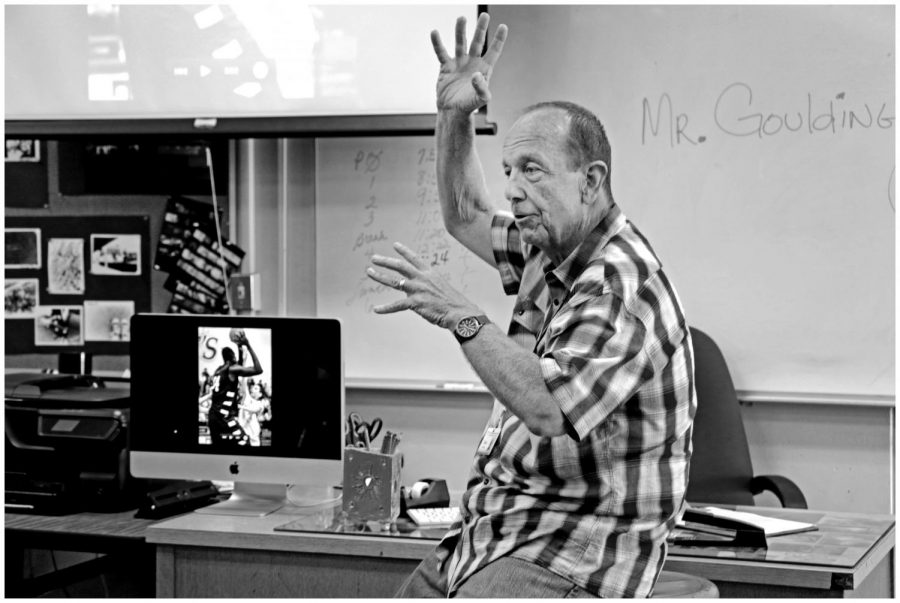Through the lens with Mike Goulding
Mike Goulding at the Los Angeles Coliseum on September 9, 2017.
“I like to see photography as a recipe to a perfect cake,” said Mike Goulding to his workshop at the Journalism Association of Community Colleges, on March 28, 2018, as he explained how photography required depth of field, shutter speed and light.
Mike Goulding is an adjunct photojournalism professor at Cal State Long beach, as well as a freelance photojournalist. Through his career, he has photographed the Olympics, the 1992 Los Angeles riots, South African apartheid and more.
Goulding’s father was a journalist, and Goulding became a copy messenger for their newsroom while he was in junior college. A fellow copy messenger in the newsroom lent his camera to Goulding, and from then on he fell in love with the art and bought his own camera.
He began to take classes and studied the photos of photographers his father knew, many of whom were known to be great photographers of the time.
He started an internship with a section of the Los Angels Times, and from there picked up a job that led to progressively bigger jobs.
When it came to covering the Olympics, Goulding describes shooting with the best of the best photographers. He emphasized having trust in yourself when covering such events, and knowing that you would not be there if you were not capable of such.
Goulding gave this tip: make sure you are prepared through your equipment, your knowledge of the venue and the photographers and people involved, and know what is required of you.
“The preparation is the fundamental in doing big events,” said Goulding. (When) “covering wars, the Olympics, or even a high school basketball game.”
This is so you’re not getting over an element of surprise once at the event while you should be shooting pictures. He mentions getting to know the other photographers and doing sound checks and prep work before the event, since they are under just as much under pressure as you.
Goulding describes doing his first big event, a game between the Lakers and the Celtics, and how he was surrounded by action and excitement. At his very first event, a fight broke out between major players and he had to react with his camera. His advice to fellow photographers is to not keep looking down at your camera, but to just keep shooting.
“Until you’re actually doing it, until you’re in the noise, it doesn’t really ring true,” said Goulding.
Being excited is good and keeps you on the edge, according to Goulding. If you react properly, you’ll get great pictures and become increasingly more comfortable in situations. You maintain the edge of excitement and you also become more confident.
Goulding states that he has obtained these assignments through working towards his goal every single day. There was not a day he was not doing something to bring him closer to his goals. He did not wait for people to even assign him work, he would just do it.
“Once you get those games you fight for, you have to deliver,” states Goulding. “That means you work your ass off, that means you work twice as hard when you are there. So the next time a big event comes up, they don’t have any choice but to give it to you.”
According to Goulding, the Olympics in Rio de Janeiro felt like things were just happening in front of him, and there is a saying that while photography can be luck, the good photographers get luckier.
Goulding also describes the excitement and danger of covering events such as the LA riots, also known as the Rodney King riots. He originally had a reporter who drove around to different locations, and Goulding would jump out of the car, take a few shots, and jump back in within moments. These were riots where fires and people being killed were actively taking place, so location and timing were crucial.
But Goulding quickly realized the reporter did not know the safest moments and locations to shoot in the chaos, and so he had a fellow photographer drive with him and they took turns driving, hopping out and shooting.
As for what it is like to be a professional photographer, Goulding explains that you work all the time and almost 16 hours a day if not more. However it does not feel like work, and when you get that picture of the day it brings about great excitement.
“What you see when you see those photos, is the thousands of other photographers crammed in small space trying to get their shot,” said Goulding. “All of them with as legitimate credentials as you have, and you have to out shoot them.”
Mindy Schauer, a friend of Goulding for more than twenty years, describes Goulding as a unique photographer because of his passion and drive, as well as his ability to connect with people, and his curiosity to learn. Just as Goulding mentioned, Schauer states that part of Goulding’s success is due to him being driven, and having ambition and confidence.
“He relates well with people and knows how to tell their story photographically,” stated Schauer.
Goulding became an adjunct professor 2 years ago to teach others the art that he has loved throughout his life, while also continuing his work through freelancing. He thoroughly enjoys his teaching and showing his students the rewards of photography.
Goulding believes the biggest rewards of photography is the way it allows you to see the world differently, in a much richer state. He relates it to musicians and painters, and how they experience the world.
“Through that, you become an enriched person, at a depth most people never have,” said Goulding.







